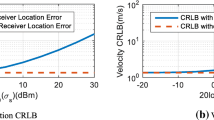Abstract
This paper considers active localization of a stationary target using time delay or together with Doppler shift measurements obtained by moving sensors. Non-negligible sensor motion effect occurs in the localization system when the dynamic monostatic sensors send and receive signals during its motion. The proposed new accurate models for time delay and Doppler shift are able to make up the sensor motion effect. Closed-form solutions when ignoring the sensor motion of the proposed models are derived to give an approximate position estimate. The solutions are further refined by the proposed models and Taylor series linearization to remove the effect caused by sensor motion. The simulations show that the refined solutions can increase the localization performance efficiently and the accuracy can reach the Cramér-Rao lower bound (CRLB).










Similar content being viewed by others
References
Rui, L., & Ho, K. C. (2015). Efficient closed-form estimators for multistatic sonar localization. IEEE Transactions on Aerospace and Electronic Systems, 51(1), 600–614.
Simakov, S. (2008). Localization in airborne multistatic sonars. IEEE Journal of Oceanic Engineering, 33(3), 278–288.
Kim, S., Ku, B., Hong, W., & Ko, H. (2008). Performance comparison of target localization for active sonar systems. IEEE Transactions on Aerospace and Electronic Systems, 44(4), 1371–1380.
Yang, L., Yang, L., & Ho, K. C. (2016). Moving target localization in multistatic sonar by differential delays and Doppler shifts. IEEE Signal Processing Letters, 23(9), 1160–1164.
Li, Z., Dosso, S. E., & Sun, D. (2016). Motion-compensated acoustic localization for underwater vehicles. IEEE Journal of Oceanic Engineering, 41(4), 840–851.
Jondhale, S. R., Maheswar, R., & Lloret, J. (2022). Received signal strength based target localization and tracking using wireless sensor networks. Springer International Publishing.
Jondhale, S. R., & Deshpande, R. S. (2018, February). Tracking target with constant acceleration motion using Kalman filtering. In 2018 international conference on advances in communication and computing technology (ICACCT) (pp. 581-587). IEEE.
Jondhale, S. R., Mohan, V., Sharma, B. B., Lloret, J., & Athawale, S. V. (2022). Support vector regression for mobile target localization in indoor environments. Sensors, 22(1), 358.
Newman, P., & Leonard, J. (2003). Pure range-only sub-sea SLAM. In 2003 IEEE International Conference on Robotics and Automation (Cat. No. 03CH37422) (Vol. 2, pp. 1921-1926). Ieee.
Thomson, D., & Dosso, S. (2013). AUV localization in an underwater acoustic positioning system (pp. 1-6). IEEE.
Jia, T., Ho, K. C., Wang, H., & Shen, X. (2020). Localization of a moving object with sensors in motion by time delays and Doppler shifts. IEEE Transactions on Signal Processing, 68, 5824–5841.
Wang, Y., & Ho, K. C. (2017). TDOA positioning irrespective of source range. IEEE Transactions on Signal Processing, 65(6), 1447–1460.
Wang, G., Li, Y., & Ansari, N. (2013). A semidefinite relaxation method for source localization using TDOA and FDOA measurements. IEEE Transactions on Vehicular Technology, 62(2), 853–862.
Paull, L., Saeedi, S., Seto, M., & Li, H. (2014). AUV navigation and localization: A review. IEEE Journal of Oceanic Engineering, 39(1), 131–149.
Yan, J., Zhao, H., Luo, X., Wang, Y., Chen, C., & Guan, X. (2019). Asynchronous localization of underwater target using consensus-based unscented Kalman filtering. IEEE Journal of Oceanic Engineering, 45(4), 1466–1481.
Jia, T., Ho, K. C., Wang, H., & Shen, X. (2019). Effect of sensor motion on time delay and doppler shift localization: Analysis and solution. IEEE Transactions on Signal Processing, 67(22), 5881–5895.
Jia, T., Wang, H., Wang, G., & Ho, K. C. (2022). Localization using time-delay and doppler shift by moving monostatic sensors. IEEE Transactions on Aerospace and Electronic Systems, 58(3), 2560–2567.
Amar, A., Leus, G., & Friedlander, B. (2012). Emitter localization given time delay and frequency shift measurements. IEEE Transactions on Aerospace and Electronic Systems, 48(2), 1826–1837.
Sabet, M. T., Sarhadi, P., & Zarini, M. (2014). Extended and Unscented Kalman filters for parameter estimation of an autonomous underwater vehicle. Ocean Engineering, 91, 329–339.
Jia, T., Wang, H., Shen, X., & Yan, Y. (2020). Accurate closed-form solution for moving underwater vehicle localization using two-way travel time. Electronics, 9(4), 565.
Funding
This work is supported by the National Natural Science Foundation of China (62201418, 62192714, 62031021), and the Fundamental Research Funds for the Central Universities (XJS220203).
Author information
Authors and Affiliations
Contributions
Conceptualization, T. Jia and X. Shen; methodology, T. Jia and C. Gao; software, T. Jia and C. Gao; writing original draft preparation, T. Jia; writing review and editing, H. Liu and X. Shen. All authors have read and agreed to the published version of the manuscript.
Corresponding author
Ethics declarations
Conflict of interest
The authors declare no competing interests.
Additional information
Publisher's Note
Springer Nature remains neutral with regard to jurisdictional claims in published maps and institutional affiliations.
Rights and permissions
Springer Nature or its licensor (e.g. a society or other partner) holds exclusive rights to this article under a publishing agreement with the author(s) or other rightsholder(s); author self-archiving of the accepted manuscript version of this article is solely governed by the terms of such publishing agreement and applicable law.
About this article
Cite this article
Jia, T., Gao, C., Shen, X. et al. Target localization using time delay and Doppler shift by compensating the motion effect. Telecommun Syst 85, 415–424 (2024). https://doi.org/10.1007/s11235-023-01086-2
Accepted:
Published:
Issue Date:
DOI: https://doi.org/10.1007/s11235-023-01086-2




